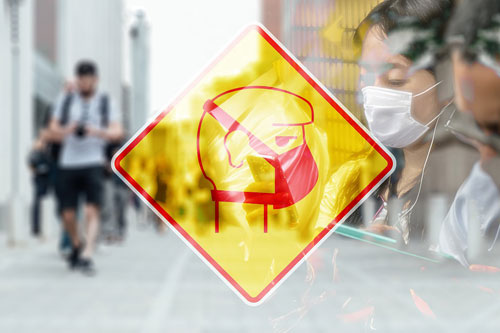Two cases of Wuhan coronavirus reported in San Benito County
Two cases of 2019-Novel Coronavirus (2019-nCoV) were confirmed Sunday in San Benito County, about 100 miles north of Paso Robles. The confirmed cases are related; husband and wife, and both are 57 years of age, according to San Benito County Public Health Services. The husband recently traveled from Wuhan, China, his wife had not. Therefore, there has been person-to-person transmission. The patients were first placed in home isolation.
The patients showed worsening symptoms late Sunday night and were referred for medical evaluation. “It was then determined that both patients needed to be admitted to a hospital equipped for a higher level of care. The patients have been transferred out of San Benito County by specialty ambulance,” said Dr. Marty Fenstersheib, San Benito County Health Officer.
Even with news of this case, the risk to the general public remains low because the patient remained at home. San Benito County residents, students, workers, and visitors should continue to engage in their regular activities and practice good health hygiene since this is the height of flu season. Anyone with respiratory symptoms, such as a cough, sore throat, or fever, should stay home, practice proper cough etiquette and hand hygiene, and limit their contact with other people.
San Benito County Public Health Services is in consultation with the Centers for Disease Control and Prevention (CDC) and the California Department of Public Health (CDPH).
The two new cases bring the total in the United States to 11. There are two cases in Santa Clara County and two in Southern California. Outside of California, there are two cases in Chicago and one case each in Massachusetts, Arizona and Washington state. China confirmed 17,205 infections and 361 deaths as of Sunday. For the latest updates, check the New York Times.
Over the weekend, three large tents were erected on the tarmac of March Air Reserve Base — where 195 coronavirus evacuees remained under federal quarantine orders — as a precaution in case additional planes carrying passengers who need medical screening are unexpectedly rerouted to the base, officials said Sunday.
San Benito County Public Health Services issued recommended guidelines concerning the virus. Some key points include:
If you have not been to China, or been in close contact with someone who has been to China and is sick, your risk is very low.
CDC guidance indicates that people who have casual contact with a case (in the same grocery store or movie theater) are at minimal risk of developing an infection.
If you have recently been to China and feel sick, please stay home and avoid contact with others.
Contact your doctor’s office or emergency room and tell them about your recent travels and symptoms.
Cover your mouth and nose with a tissue or your sleeve (not your hands) when coughing or sneezing.
“We continue to monitor the situation closely to protect the health of San Benito County residents and limit the spread of this virus,” said Dr. Fenstersheib. “We are working closely with Bay Area health officials, local health care providers, and community partners.”
“While the virus is considered a serious public health threat, based on current information, the risk to the general public in California and locally in San Benito County continues to be low at this time,” said Dr. Fenstersheib.
Symptoms of 2019-nCoV
Typically, human coronaviruses cause mild-to-moderate respiratory illness. Symptoms are very similar to the flu, including fever, cough, congestion, and/or shortness of breath. Older adults and people with underlying health conditions may be at increased risk for severe disease.
Tips to Protect Yourself and Others
No additional precautions are recommended at this time beyond the simple daily precautions that everyone should always take, such as:
1. Washing hands with liquid soap and water, and rubbing for at least 20 seconds;
2. Covering your mouth and nose with a tissue or your sleeve (not your hands) when coughing or sneezing; and
3. Staying home if you are sick.
Since flu activity will continue to remain high during this flu season, and symptoms of coronavirus are similar to the flu, health officials also recommend getting a flu shot to protect yourself and others from the flu.
CDC: What to expect next
More cases are likely to be identified in the coming days, including more cases in the United States, according to the U.S. Centers for Disease Control. Given what has occurred previously with MERS and SARS, it’s likely that person-to-person spread will continue to occur. It would not be surprising if person-to-person spread in the United States were to occur. Cases in healthcare settings, like hospitals, may also occur.
CDC Response
- CDC is closely monitoring this situation and is working with WHO.
- CDC established a 2019-nCoV Incident Management Structure on January 7, 2020. On January 21, 2020, CDC activated its Emergency Response System to better provide ongoing support to the 2019-nCoV response.
- On January 23, 2020, CDC again raised its travel alert for the coronavirus outbreak. The travel notice for Wuhan City was raised from Level 2: Practice Enhanced Precautions to Level 3: Avoid Nonessential Travel. CDC also issued a Level 1: Practice Usual Precautions for the rest of China.
- CDC also is conducting entry screening of passengers on direct and connecting flights from Wuhan, China to five major airports: Atlanta (ATL), Chicago (ORD), Los Angeles, (LAX) New York city (JFK), and San Francisco (SFO).
- CDC issued an updated interim Health Alert Notice (HAN) Advisory to inform state and local health departments and health care providers about this outbreak on January 17, 2020.
- CDC teams have been deployed to support the ongoing investigation in Washington and Illinois to support the ongoing investigations of the two cases in the United States.
- CDC has developed a real time Reverse Transcription-Polymerase Chain Reaction (rRT-PCR) test that can diagnose 2019-nCoV in respiratory and serum samples from clinical specimens. On January 24, 2020, CDC publicly posted the assay protocol for this test. Currently, testing for this virus must take place at CDC, but in the coming days and weeks, CDC will share these tests with domestic and international partners through the agency’s International Reagent Resourceexternal icon.
- CDC uploaded the entire genome of the virus from the first reported case in the United States to GenBank.
- CDC also is growing the virus in cell culture, which is necessary for further studies, including for additional genetic characterization.
CDC Recommends
While the immediate risk of this new virus to the American public is believed to be low at this time, everyone can do their part to help us respond to this emerging public health threat:
- For everyone: It’s currently flu and respiratory disease season and CDC recommends getting vaccinated, taking everyday preventive actions to stop the spread of germs, and taking flu antivirals if prescribed.
- For healthcare professionals:
- Be on the look-out for people with travel history to Wuhan, China and fever and respiratory symptoms.
- If you are a healthcare professional caring a 2109-nCoV patient, please take care of yourself and follow recommended infection control procedures.
- For people who may have 2019-nCoV infection: Please follow CDC guidance on how to reduce the risk of spreading your illness to others.
- For travelers: Stay up to date with CDC’s travel health notices related to this outbreak.
Comments
The news staff of the Paso Robles Daily News wrote or edited this story from local contributors and press releases. The news staff can be reached at info@pasoroblesdailynews.com.




















